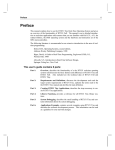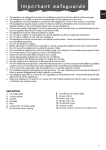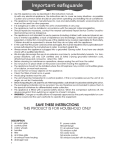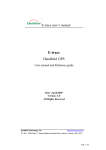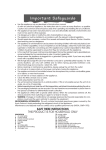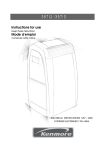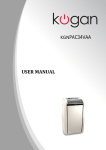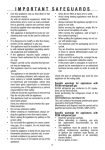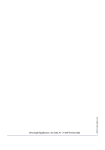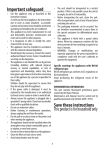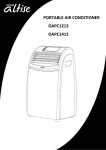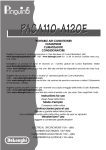Download DeLonghi Pinguino PAC AN110
Transcript
I m p o r t a n t s a f e g u a rd s EN • Use the appliance as described in this instruction manual only. As with all electrical equipment, whilst the instructions aim to cover as many eventualities as possible, caution and common sense should be used when operating and installing the appliance. • This appliance is designed for home air conditioning and must not be used for other purposes. • It is dangerous to modify or alter the characteristics of the appliance in any way. • The appliance must be installed in conformity with national legislation regulating electrical equipment and installations. • If the appliance requires repair, contact the manufacturer's Customer Services only. Repairs carried out by unauthorised personnel may be dangerous. • This appliance must be used exclusively by adults. • The appliance is not intended for use by persons (including children) with reduced physical, sensory or mental capabilities, or lack of experience and knowledge, unless they have been given supervision or instruction concerning use of the appliance by a person responsible for their safety. Children must be supervised to ensure they do not play with the appliance. • The appliance must be connected to an efficient earth system. Have your electricity installation checked by a qualified electrician. • Do not use extension cables. • Before cleaning or maintenance, always unplug the appliance from the mains socket. • Never unplug the appliance by pulling on the power cable. • Do not install the appliance in rooms containing gas, oil or sulphur. Do not install near sources of heat. • Keep the appliance at least 50 cm away from flammable substances (alcohol etc) or pressurised containers (e.g. aerosol cans). • Do not rest heavy or hot objects on top of the appliance. • Clean the air filter at least once a week. • Avoid using heating appliances near the air conditioner. • The appliance must always remain upright or laid on one side during transportation. Before moving the appliance, empty the internal circuit completely of water. After moving the appliance, wait at least 1 hour before starting it. • When putting the appliance away, do not cover with plastic bags. • The materials used for packaging can be recycled. You are therefore recommended to dispose of them in special differentiated waste collection containers. • At the end of its working life, consign the appliance to a specialist collection centre. • If the power cable is damaged, it must be replaced by the manufacturer or the manufacturer's Customer Services in order to avoid all risk. SPECIFIC WARNINGS FOR APPLIANCES WITH R410A* REFRIGERANT GAS R410A refrigerant gas conforms to EC regulations on the environment. Avoid perforating the refrigerant circuit of the appliance. ENVIRONMENTAL INFORMATION: This unit contains fluorinated greenhouse gases covered by the Kyoto Protocol. Maintenance and disposal must be carried out by qualified personnel only (R410A, GWP=1975). * Verify the type of refrigerant gas used in your appliance on the rating plate. 17 Pre p a r i n g f o r u s e DESCRIPTION 1 2 3 4 5 6 7 8 9 10 11 12 13 14 15 16 17 18 19 20 Air outlet grille Control panel Handles Castors Filter Evaporator air intake grille Air exhaust hose housing Condenser air intake grille Power cable Drain hole bung Wall flange Air exhaust hose Hose adapter (2 pieces) Wall mounting accessory Bar grille Bung for hole in bar Bar Screws Window outlet Remote control ELECTRICAL CONNECTIONS Before plugging the appliance into the mains socket, check that: • the mains power supply corresponds to the value indicated on the rating plate on the back of the appliance; • the power socket and mains electricity supply are adequate for the appliance; • the mains socket matches the plug. If this is not the case, have the plug replaced; • the mains socket is adequately earthed. Failure to follow these important safety instructions absolves the manufacturer of all liability. The power cable must be replaced by a qualified professional only. The instructions below will enable you to prepare your air conditioner for operation as efficiently as possible. Before use, make sure the air intake and outlet grilles are unobstructed. AIR CONDITIONING WITHOUT INSTALLATION Vertically sliding window Just a few simple steps and your air conditioner will ensure your comfort: • Screw one of the hose adapters 13 to one end of the air exhaust hose. 12 . • Fit the bar grille 15 to the bar 17 and fix with the four screws provided 18 (fig. B). • Fit the other adapter 13 to the air exhaust hose housing 7 at the back of the appliance (see fig. A). • Screw the end of the hose without adapter to the adapter previously mounted on the appliance (see fig. A). B • Open the window. A 18 • Place the bar 17 in the window and extend it for the width of the window (fig. C). • Once the bar has been extended, fix it by screwing up the remaining two screws supplied. • Lower the window (fig. D). Pre p a r i n g f o r u s e EN • Open the window or French window C D slightly and position the outlet shown in fig. G 19 as • Place the air conditioner near the window. Insert the assembled air exhaust hose 12 in the grille on the bar 17 (fig. E). Make sure the air exhaust hose is not blocked. • When the appliance is not in use, the hole in the bar can be closed with the bung G 16 provided. Keep the air hoses as short and free of curves as possible to avoid bottlenecks. E Double window • Fit the window outlet 19 to the air exhaust hose 12 pre-assembled as shown in fig. F. 2 1 F 19 Pre p a r i n g f o r u s e AIR CONDITIONING WITH INSTALLATION If required, your appliance can also be installed semi-permanently (Fig. H). • Fit the flange accessory provided 11 in the hole. • Fit the adapter 13 to the air exhaust hose housing 7 at the back of the appliance (see fig. A). 14 • Screw the wall mounting accessory to the air exhaust hose 12 or, if necessary, unscrew the adapter exhaust hose 12 13 from the air and replace it with the wall installation terminal 14 (fig. L). 30 cm 1 30 cm H Proceed as follows: • Drill a hole (dia. 134 mm) in an outside wall or through a window pane. Respect the height and sizes of the hole as shown in fig. I. 2 L • Fit the end of the hose 12 to the flange 11 as shown in fig. M. 134 MAX100 cm MIN 35 cm in the window pane I in the wooden kickboard of a French window in the wall: you are recommended to insulate the section of wall using suitable insulation. M When the hose 12 is not fitted, the hole can be closed with the flange cap 11 . Keep the air hoses as short and free of curves as possible to avoid bottlenecks. 20 PLEASE NOTE: When installing the air conditioner semi-permanently, you should leave a door slightly open (as little as 1 cm) to guarantee correct ventilation. Control panel EN THE CONTROL PANEL G H I L D A B E °C °F F C S R Q P O N M DESCRIPTION OF THE CONTROL PANEL A ON /OFF button B MODE selection button Air conditioning, dehumidifying, fan C Reduce temperature/programme mode time button D Timer button E Fan speed button (MAX/MED/MIN) F Increase temperature/programme mode time button G Air conditioning symbol H Dehumidifying symbol I Fan symbol L Alarm symbol M Fan speed indicator N Temperature scale indicator O Time indicator P Set temperatures, room temperature and programmed on/off time Q Timer symbol R Room temperature symbol S Set temperature symbol Never turn the air conditioner off by unplugging from the mains. Always press the button, then wait for a few minutes before unplugging. This allows the appliance to perform a cycle of checks to verify operation 21 Operation TURNING THE APPLIANCE ON Plug the appliance into the mains. Two lines appear on the display indicating that the appliance is in stand-by. Press the button (A). The first time the appliance is turned on, it will be in air conditioning mode. Room temperature will be displayed and fan speed will be at minimum. When turned on subsequently it will be in the same mode as when last turned off. Press the MODE button (B) until the symbol corresponding to the required mode is displayed: Air conditioning symbol (G) Dehumidifying symbol (H) Fan symbol (I) AIR CONDITIONING MODE Ideal for hot muggy weather when you need to cool and dehumidify the room. To set this function correctly: • Press the MODE button a number of times until the air conditioning symbol appears. Room temperature is displayed. • Select the target temperature by pressing the button (F) or button (C) until the required value is displayed. During selection, the temperature flashes. After 10 seconds, room temperature is displayed again. • Select the required fan speed by pressing the button. There are 3 speeds available: High speed: to achieve the target temperature as rapidly as possible Medium speed: reduces noise levels but still maintains a good level of comfort Low speed: for silent operation The most suitable temperature for the room during the summer varies from 24 to 27°C. You are recommended, however, not to set a temperature much below the outdoor temperature. 22 °C °C Operation EN DEHUMIDIFYING MODE Ideal to reduce room humidity (spring and autumn, damp rooms, rainy periods, etc). For this mode, the appliance should be prepared in the same way as for air conditioning, with the air exhaust hose attached to enable the moisture to be discharged outside. To set this function correctly: • Press the MODE button a number of times until the dehumidifying symbol appears. °C NOTE: In this mode, with room temperature above 25 degree C, the fan speed is adjustable. If the temperature is below, fan speed is selected automatically by the appliance and cannot be set manually. FAN MODES When using the appliance in this mode, the air exhaust hose does not need to be attached. To set this function correctly: • Press the MODE button a number of times until the fan symbol appears. • Select the required fan speed by pressing the button. There are 3 speeds available: °C °C High speed: for maximum fan power; Medium speed: reduces noise levels but still maintains a good level of comfort; Low speed: for silent operation. PLEASE NOTE: To change the unit of measurement for the displayed temperature, press the and buttons together for 3 seconds. °C °C °F 23 Setting the timer SETTING THE TIMER The timer can be used to delay when the appliance comes on or goes off. This avoids wasting electricity by optimising operating periods. How to programme delay ON • Plug the appliance into the mains socket. It will be in STANDBY. • Press the timer button (D). The timer symbol Q comes on. • Use the (F) or (C) buttons to set the number of hours delay before the appliance comes on. They increase or decrease the time in steps of an hour. The appliance can be set to come on within the next 24 hours. Five seconds after the timer has been set, the display dims and the setting is memorised. PLEASE NOTE: after setting, the operating mode and fan speed can be modified. To cancel the timer programme, press the timer button (D) again. Pressing the ON/OFF button (A) cancels the timer programme and the air conditioner comes on immediately in the selected mode. How to programme delay OFF • Delay OFF can be programmed in any operating mode - air conditioning/fan/dehumidifying. • Press the timer button (D). The timer on symbol Q comes on. • Use the (F) or (C) buttons to set the number of hours delay before the appliance goes off. They increase or decrease the time in steps of an hour. The appliance can be set to go off within the next 24 hours. Five seconds after the timer has been set, the operating mode is displayed and the timer symbol remains on. At the set time, the air conditioner goes off and remains in standby. To cancel the timer programme, press the timer button (D) again. The timer symbol goes off. PLEASE NOTE: after setting, the operating mode and fan speed can be modified. 24 °C Using the remote control unit EN MODELS WITH REMOTE CONTROL • Point the remote control at the receiver on the air conditioner. The remote control must be no more than 5 metres away from the appliance (without obstacles between the remote control and the receiver). • The remote control must be handled with extreme care and respect. Do not drop it or expose it to direct sunlight or sources of heat. MAX 5 metres DESCRIPTION OF THE REMOTE CONTROL 17) "ON/OFF" button 18) "MODE" button 19) Temperature decrease/increase and programme mode button 20) "TIMER" button 21) Fan speed button (MAX/MED/MIN) 22) °F/°C switching button Replacing the batteries • Remove the cover on the back of the remote control; • Insert two new LR03 “AAA” 1.5V batteries, making sure they are in the correct position (see the instructions inside the battery compartment); • Replace the cover. 17 19 18 21 20 22 If the remote control unit is replaced or discarded, the batteries must be removed and disposed of in accordance with current legislation as they are harmful to the environment. Do not mix alkaline, standard (zinc-carbon) and rechargeable (nickel-cadmium) batteries. Do not throw the batteries in the fire as they could explode or leak dangerous liquids. TURNING THE APPLIANCE ON Plug the appliance into the mains. Press the ON/OFF button of the remote control (17) (when turned on, the air conditioner starts operating in the same mode as when last turned off). Press the MODE button (18) button to select the required mode: AIR CONDITIONING (COOLING) DEHUMIDIFYING FAN ONLY The light corresponding to the selected mode lights up on the control panel. For air conditioning/dehumidifying/fan only settings and programming the timer, see the paragraphs on pages 22-23. 25 Tips To get the best from your air conditioner, follow these recommendations: • close the doors and windows of the room to be air conditioned. The only exception is when the appliance is installed through a hole in the wall. In this case, you are recommended to leave a slight draught through a door or window to guarantee correct ventilation. • Never use the appliance in very damp rooms (laundries for example). • Never use the appliance outdoors. close doors and windows • Protect the room from direct exposure to the sun by partially closing curtains and/or blinds to make the appliance much more economical to run; • Never rest objects of any kind on the air conditioner; • Do not obstruct the air intake 6 or outlet 1 ; • Make sure there are no heat sources in the room. close blinds or curtains • Make sure the air conditioner is on a flat floor. do not cover the appliance 26 Cleaning EN Before cleaning or maintenance, turn the appliance off by pressing the ON/OFF button (A) or in models with remote control, by pressing the ON/OFF button 17 , then always unplug the appliance from the mains socket. CLEANING THE CABINET You should clean the appliance with a slightly damp cloth then dry with a dry cloth. For safety reasons, never wash the air conditioner with water. Precautions Never use petrol, alcohol or solvents to clean the appliance. Never spray insecticide liquids or similar. After washing, leave the filter to dry. To remount, put the filter back in its housing. START OF SEASON CHECKS Make sure the power cable and plug are undamaged and the earth system is efficient. Follow the installation instructions precisely. OEND OF SEASON OPERATIONS To empty the internal circuit completely of water, remove the bung. Allow all the water to drain into a basin (fig. O). When all the water has been drained, put the bung back in place. Clean the filter and dry thoroughly before putting back. CLEANING THE AIR PURIFYING FILTERS To keep your air conditioner working efficiently, you should clean the dust filter every week of operation. The filter is housed in the intake grille. To clean the filter, extract as shown in fig. N. Use a vacuum cleaner to remove the dust collected on the filter. If it is very dirty, immerse in warm water and rinse a number of times. The water should never be hotter than 40°C. N O 27 Troubleshooting PROBLEM CAUSE REMEDY The air conditioner does not come on • • • there is no current the appliance is not plugged into the mains The safety device has tripped • • • wait plug into the mains socket Contact your local Customer Services The air conditioner works for a short time only • the air exhaust hose has a constriction • • the air exhaust hose is blocked • • there are bends in the air exhaust hose • position the air exhaust hose correctly check there are no obstacles obstructing air discharge eliminate the bends • • window open there are heat sources in the room (burner, lamp, etc) the exhaust hose is detached air filter clogged the air conditioner is not powerful enough for the conditions or size of the room • • close the window eliminate the heat source • • connect the exhaust hose clean or replace the filter The air conditioner works, but does not cool the room • • • Particular odour in the room • the air filter is clogged • clean or replace the filter The air conditioner does not operate for about 3 minutes after restarting it • The safety device has tripped • wait for 3 minutes The alarm light (ALARM) L comes on • The tray under the appliance is full • Empty the tray (see paragraph on end-of-season operations on page 27). SELF-DIAGNOSIS The appliance has a self diagnosis system to identify a number of malfunctions. Error messages are displayed on the appliance display. IF THE APPLIANCE DISPLAYS... “Low Temperature” …THIS MEANS: room temperature is too low 28 IF THE APPLIANCE DISPLAYS... “High Temperature” …THIS MEANS: room temperature is too high IF THE APPLIANCE DISPLAYS... “Probe Failure” …THIS MEANS: contact your local Customer Services. Guarantee/technical specification GUARANTEE AND CUSTOMER SERVICES The conditions of the guarantee and customer service are given on the certificate supplied with your appliance. EN TECHNICAL CHARACTERISTICS: Power supply voltage Max. power input during air conditioning Refrigerant Cooling capacity see rating plate “ “ “ LIMIT CONDITIONS Room temperature for air conditioning 21 ÷ 35°C Transport, filling, cleaning, recovery and disposal of refrigerant should be performed by the Manufacturer's Customer Services only. The appliance should be disposed of by a specialist centre authorised by the manufacturer only. Important information for correct disposal of the product in accordance with EC Directive 2002/96/EC. At the end of its working life, the product must not be disposed of as urban waste. It must be taken to a special local authority differentiated waste collection centre or to a dealer providing this service. Disposing of a household appliance separately avoids possible negative consequences for the environment and health deriving from inappropriate disposal and enables the constituent materials to be recovered to obtain significant savings in energy and resources.As a reminder of the need to dispose of household appliances separately, the product is marked with a crossed-out wheeled dustbin. 29













